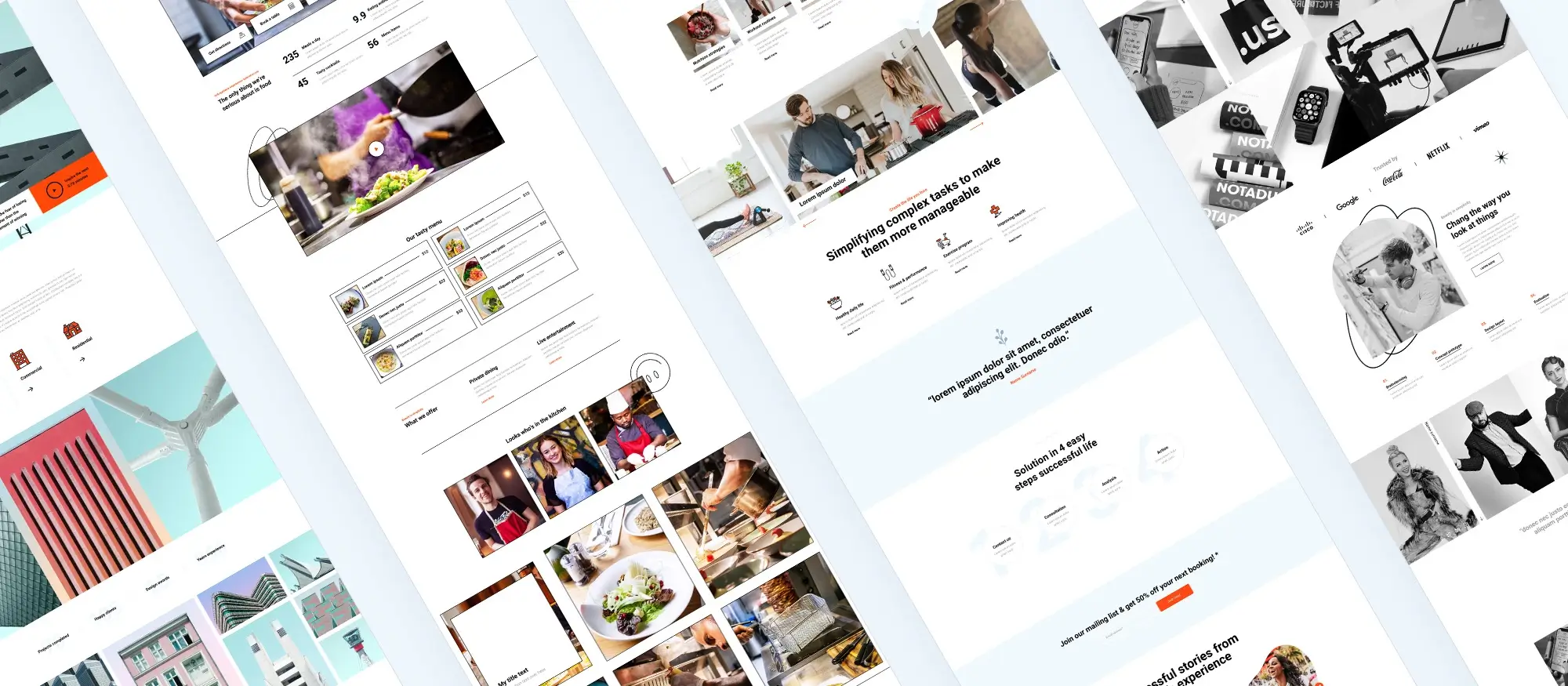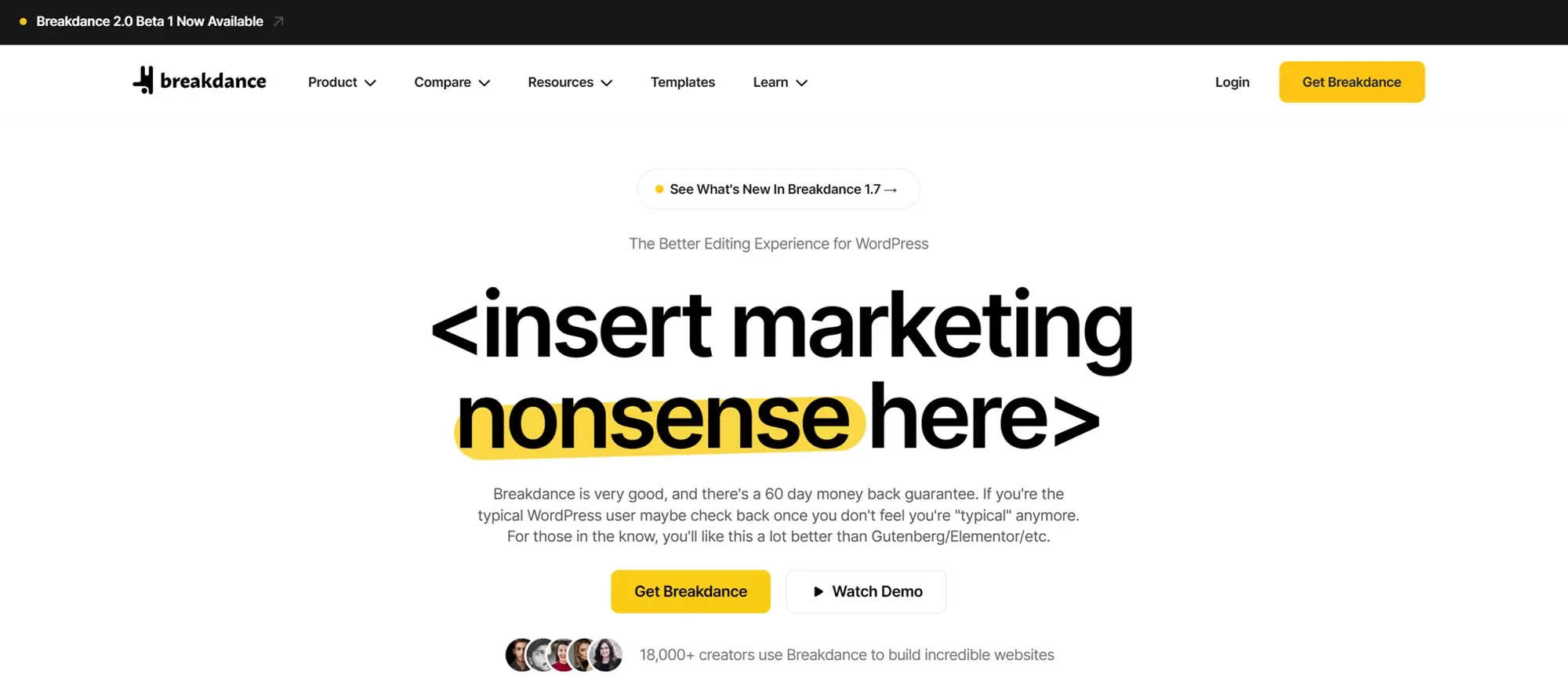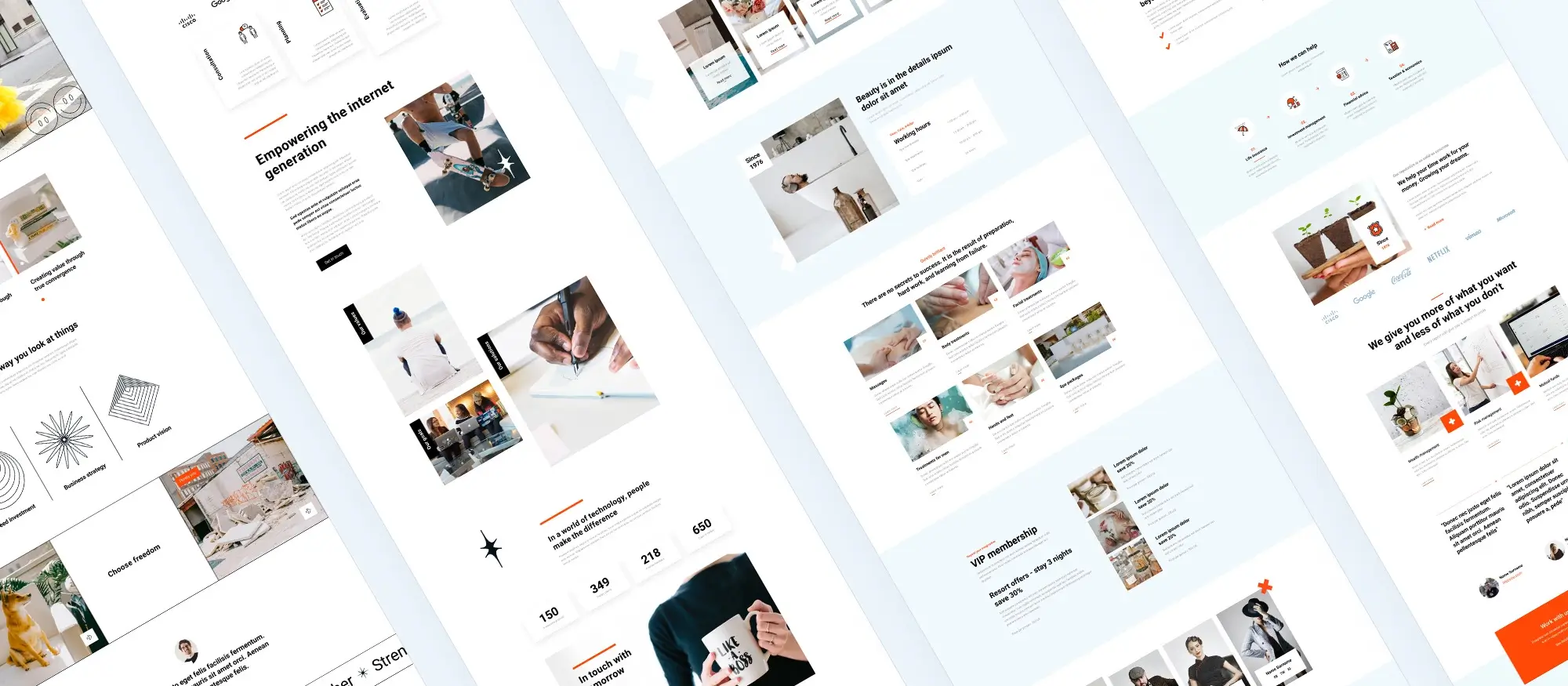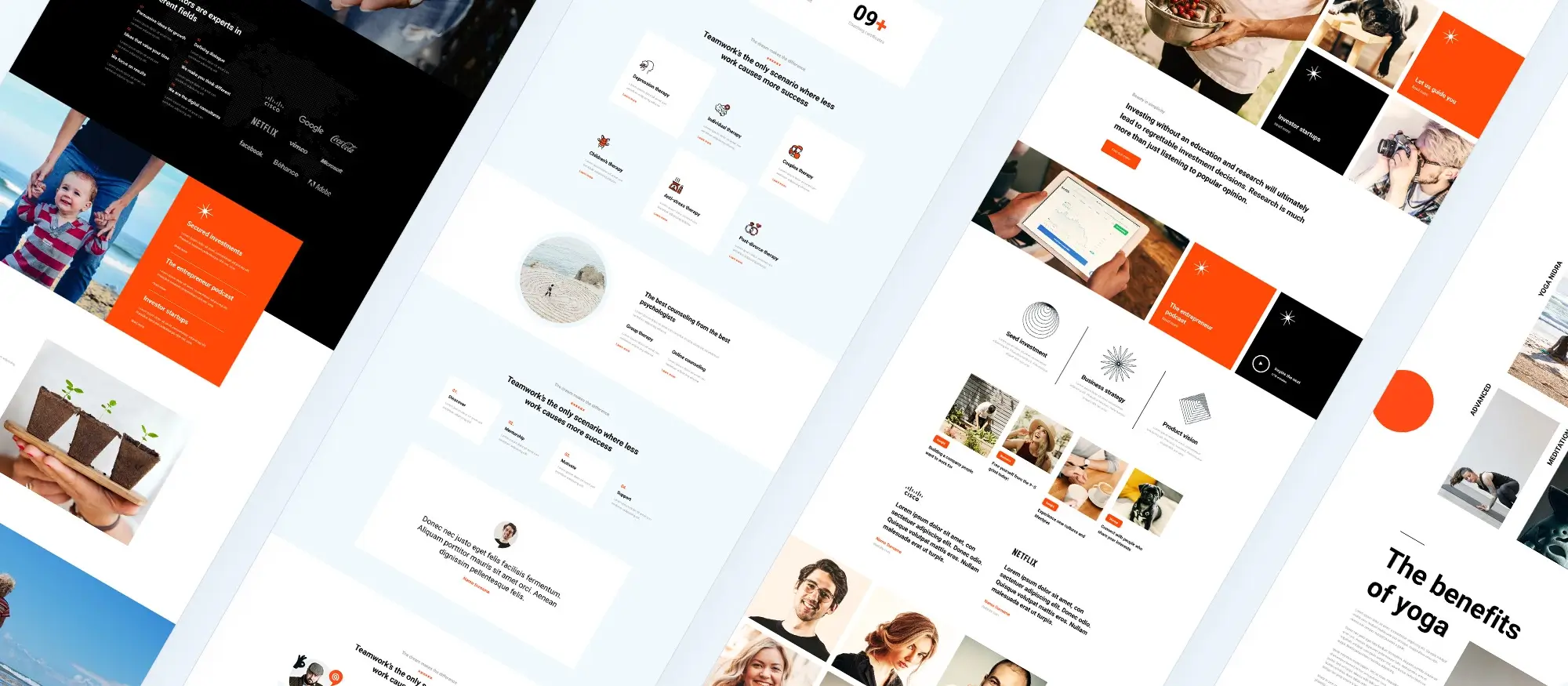What are the best Elementor alternatives for portfolio websites in 2025?
Try MaxiBlocks for free with 500+ library assets including basic templates. No account required. Free WordPress page builder, theme and updates included.

Elementor alternatives for portfolio websites: better tools for showcasing your work
Introduction
A portfolio site does more than just display your work it sets the tone for how people see you. Whether you’re a creative professional or just starting to share your projects online, your site needs to load fast, look good on any device, and be easy to update.
Elementor is a popular drag-and-drop builder for WordPress. It’s known for its visual editor, pre-made templates, and flexibility. A lot of creatives use it to build portfolio websites without needing to write code. But it’s not without drawbacks. The free version is limited. The pro version adds cost. And as you add more features, Elementor can start to slow things down, especially on image-heavy or media-rich pages.
Many users also run into plugin bloat, layout glitches after updates, or long setup times things that get in the way when you just want to get your work online and make it look sharp.
Why having a fast, well-designed portfolio site matters
Your site reflects your work. If it’s slow, cluttered, or hard to use, people might assume the same about your services. A fast, clean site builds trust, shows off your skill, and helps you get more leads or job opportunities.
Elementor’s popularity for portfolios but also its downsides
While Elementor is easy to use and full of design options, it can quickly become bloated. The free version is limited, and the pro version adds recurring costs. It also tends to slow down with large image galleries or animations things portfolios often rely on.
What this article covers
This guide breaks down the best Elementor alternatives for building strong, fast, creative portfolio sites. Whether you want something minimal, highly custom, or completely free, you’ll find tools here that suit your workflow without the usual Elementor headaches.

Why some creatives are moving away from Elementor
Elementor is one of the most widely used page builders for WordPress, especially for creatives building portfolio sites. It’s easy to get started, packed with features, and has a visual interface that appeals to non-coders. But over time, many users run into limitations performance issues, rising costs, and layout headaches that can make managing a simple portfolio more complicated than it should be.
If you’ve ever struggled with slow load times, plugin conflicts, or found yourself relying on too many third-party add-ons just to get the layout you want, you’re not alone. Plenty of users are looking for cleaner, faster, and more sustainable alternatives tools that do the job without all the extra weight. Here’s why more creatives are starting to look beyond Elementor.
Reasons to look for Elementor alternatives
Performance issues
Elementor adds a lot of extra code behind the scenes. The more widgets, animations, or effects you use, the heavier your site becomes and that means slower load times. For portfolio websites where visuals matter, slow pages can ruin the experience.
Heavy on resources
Elementor can be demanding on hosting, especially shared plans. If your site isn’t on a high-performance server, you may notice lags, especially when editing pages or loading larger galleries.
Pro features locked behind a paywall
A lot of basic things like custom headers, footers, form builder, or global styles are only available in Elementor Pro. It’s hard to build a complete site using just the free version without adding other tools or workarounds.
Steep learning curve for beginners
It’s marketed as beginner-friendly, but it can still be confusing. Between global settings, widgets, popups, theme builder, and layout quirks, it takes time to learn how everything fits together especially if you’re new to WordPress.
Incompatibility with some themes or plugins
Elementor doesn’t always play nice with other plugins or themes. Layouts can break, styles don’t always match, and plugin conflicts can make the builder unstable or clunky.
Messy HTML output
If you care about clean, lightweight code, Elementor’s output might frustrate you. It can generate lots of nested divs and inline styles, which aren’t ideal for developers or SEO.
Limited design freedom without add-ons
To unlock more advanced layouts or features, most users end up installing third-party Elementor add-ons. These can slow your site down even more and sometimes introduce bugs or inconsistencies.
Lock-in effect
If you ever remove Elementor, your content won’t stay intact. You’ll often be left with broken layouts, shortcode mess, or unstyled text. Migrating away from it can be a headache.
Expensive over time
Elementor Pro is a subscription. For one site it’s manageable, but if you’re a freelancer or agency managing multiple portfolios, the cost adds up quickly.
Better modern alternatives exist
Tools like MaxiBlocks, Bricks Builder, and Gutenberg offer many of the same design features often with cleaner output, better performance, and no recurring cost. They’re lighter, faster, and more flexible for people who want control without the bloat.
Subscribe to our newsletter
Why MaxiBlocks is a strong Elementor alternative for portfolio websites
MaxiBlocks is built for creatives designers, photographers, illustrators, developers who want to create a clean, professional site without battling a bloated editor or racking up subscription costs. It’s completely free, works inside the native WordPress editor, and includes thousands of pre-designed blocks, style cards, and layout patterns. There’s no paywall, no locked features, and no code required.
Where Elementor gets heavy and technical, MaxiBlocks stays lean and visual. It’s built with a focus on performance, accessibility, and flexibility so your site loads quickly, looks polished, and can grow with your needs.
Case study: Building a portfolio site with MaxiBlocks
Here’s how you can use MaxiBlocks to create a complete, professional portfolio website using only free tools.
Homepage
Create a strong first impression with a clean layout and standout visuals.
- Add a hero block with a short intro about who you are and what you do
- Drop in one or two eye-catching pieces of work
- Use styled navigation links or buttons to guide visitors to your portfolio or contact page
Portfolio / Work
Organise your projects clearly with a focus on visuals.
- Use gallery or image grid blocks
- Separate work into categories (branding, web, print, etc.)
- Add optional descriptions: what tools you used, your role, or the project outcome
- Enable lightbox or click-through views for deeper case studies
About Me
Share your story and personality in a way that feels genuine.
- Use an About block with image + text layout
- Add a short bio, headshot, and a few lines about your background or creative approach
- Keep it informal but informative it helps people connect
Contact
Make it easy for people to reach out.
- Add a form block or a styled email link
- Include social media icons using the built-in icon sets
- Optionally list your location or phone number if relevant
Services / What You Offer
Help clients understand what you actually do.
- Use pricing table or feature block layouts
- List packages or services clearly (e.g. brand design, website builds, illustration commissions)
- Include a CTA like “Get in touch” or “Request a quote”
Resume / CV (optional)
For job seekers or formal clients, this section adds extra credibility.
- Use text blocks or embed a downloadable PDF
- List education, awards, exhibitions, or published work
- Keep the formatting clean and easy to scan
Testimonials / Client Feedback
Add social proof with short quotes.
- Use testimonial blocks with images and names
- Sprinkle them through your homepage or service pages
- Even one or two strong quotes can make a difference
Blog or Journal (optional)
Useful for SEO and showing you’re active.
- Share recent projects, work in progress, or creative insights
- Use the Context Loop block to pull in posts automatically
- Great for building long-term engagement
MaxiBlocks gives you everything you need to build this layout in WordPress without extra plugins, extra cost, or extra noise. It’s fast, clean, and flexible and made for people who want to spend more time creating and less time troubleshooting.

Best Elementor alternatives for portfolios
Here’s a breakdown of some of the top alternatives to Elementor for creatives building portfolio sites. Each tool has its strengths some are ideal for minimal layouts, others for full control or visual effects. Choose based on how much design flexibility, speed, or simplicity you need.
MaxiBlocks
A visual builder made for creatives who want full access to design tools without paying for upgrades.
- Key features: Drag-and-drop editing, thousands of free blocks and templates, built-in style cards, no locked features
- Pros: 100% free, clean UI, excellent performance, no need for third-party add-ons
- Cons: Newer tool, smaller community (still growing fast)
- Best for: Designers, photographers, and freelancers who want a fast, professional site with zero cost
Bricks Builder
A powerful visual builder with fine-grain control and fast front-end output.
- Key features: Real-time editing, custom layout control, dynamic content, clean code output
- Pros: Fast-loading, developer-friendly, strong visual control
- Cons: Paid (one-time cost), learning curve for beginners
- Best for: Advanced users and agencies who want full layout control and performance without bloat
Gutenberg
The native WordPress block editor simple, minimal, and already built in.
- Key features: Block-based editing, compatible with many themes, low overhead
- Pros: Lightweight, no extra cost or installs, easy to maintain
- Cons: Limited design flexibility unless paired with block add-ons
- Best for: Minimalist portfolios or creatives who want a no-fuss, fast-loading site
Kadence Blocks
A plugin that upgrades Gutenberg with more layout and design options.
- Key features: Advanced blocks (columns, galleries, CTAs), design presets, responsive controls
- Pros: Lightweight, enhances Gutenberg without sacrificing speed
- Cons: Some features locked behind paid version
- Best for: Users who like Gutenberg but want a bit more visual control and polish
Divi
A popular builder with a strong visual editor and tons of animation and design features.
- Key features: Visual editing, pre-made templates, built-in split testing, theme builder
- Pros: Large template library, highly customisable, good support
- Cons: Can be slow if not optimised, subscription pricing, heavier output
- Best for: Creatives who want bold, interactive layouts and don’t mind spending time tweaking design
GenerateBlocks
Minimalist builder focused on performance and precision layout.
- Key features: Container, grid, headline, and button blocks, clean HTML/CSS output
- Pros: Super lightweight, great SEO, perfect for developers or experienced users
- Cons: Not as beginner-friendly, fewer visual templates
- Best for: Those comfortable with WordPress who want maximum control without sacrificing speed
Build like a pro
Final comparison and thoughts
How do free Elementor alternatives compare to Elementor?
Free alternatives like MaxiBlocks, Gutenberg, Brizy, Bricks Builder, and Breakdance all offer strong features without the restrictions you’ll find in Elementor’s free version. You still get drag and drop editing, responsive design, and a solid library of templates, often with better performance and fewer limitations.
Can these free Elementor alternatives handle complex projects?
Yes. Tools like MaxiBlocks and Bricks Builder are more than capable of supporting detailed, multi-page portfolio sites with custom layouts, dynamic content, and reusable blocks. Whether you’re building a visual showcase, case study pages, or a client-facing portfolio, these tools hold up well, even at a professional level.
Limitations of free Elementor alternatives
Like anything free, there are trade offs. Some builders may lock certain features behind paid upgrades, or require a bit more setup. That said, for most users building personal or client portfolios, the free versions offer more than enough.
How MaxiBlocks stands out
MaxiBlocks gives you everything up front with no upsells, no feature locks, and no limits on usage. It includes a wide design library, global styles, clean responsive layouts, and an easy interface designed for creatives. It’s especially well suited for portfolios, where visuals and page speed matter most.
Final thoughts
If you’ve outgrown Elementor or want something cleaner, faster, or more affordable, it’s worth exploring what else is out there. Whether you’re a freelancer, student, or pro, tools like MaxiBlocks, Bricks, Gutenberg, Kadence, Divi, Brizy, and Breakdance all offer different paths to building a standout portfolio site. The right tool makes your work easier to publish and better to experience. Choose the one that fits how you create.
Discover the best Elementor alternatives for WordPress
Explore a complete collection of Elementor alternatives with tips, comparisons, and tutorials for every type of WordPress site.
FAQs about Elementor alternatives for portfolio websites
What are some good Elementor alternatives for portfolio websites?
One notable Elementor alternative for portfolio websites is MaxiBlocks. It provides a comprehensive set of features tailored for creating and managing portfolios, ensuring flexibility and ease of use in showcasing work.
Why should individuals consider MaxiBlocks as one of the Elementor alternatives for portfolio websites?
MaxiBlocks offers advanced customization options, seamless integration with various media types, and a user-friendly interface. This makes it an excellent choice for those looking for efficient Elementor alternatives for portfolio websites.
How does MaxiBlocks compare to other Elementor alternatives for portfolio websites?
MaxiBlocks provides similar functionalities to Elementor but with additional features designed specifically for portfolio websites, such as customizable portfolio layouts, high-resolution media support, and enhanced performance optimizations.
Can MaxiBlocks handle large portfolios as one of the Elementor alternatives for portfolio websites?
Yes, MaxiBlocks is designed to manage large portfolios effectively. It supports robust portfolio management features, high scalability, and efficient workflows suitable for showcasing extensive work collections.
Is MaxiBlocks cost-effective as one of the Elementor alternatives for portfolio websites?
MaxiBlocks offers competitive pricing plans that cater to the budgetary constraints of individuals and businesses creating portfolio websites. With its feature-rich platform, it provides great value for money, making it a cost-effective Elementor alternative for portfolio websites.
What kind of support can users expect from MaxiBlocks as an Elementor alternative for portfolio websites?
MaxiBlocks provides excellent customer support, including dedicated assistance for portfolio websites. This includes comprehensive documentation, tutorials, and a responsive support team to help with any issues.
Does MaxiBlocks offer design templates and themes suitable as an Elementor alternative for portfolio websites?
MaxiBlocks comes with a wide range of professional templates and themes tailored for portfolio websites. These templates are highly customizable, allowing users to create unique and visually appealing portfolios.
How easy is it to migrate from Elementor to MaxiBlocks as an Elementor alternative for portfolio websites?
MaxiBlocks offers straightforward migration tools and support to help users transition from Elementor smoothly. This ensures minimal downtime and disruption during the migration process.
Can MaxiBlocks be integrated with other tools commonly used for portfolio websites as an Elementor alternative for portfolio websites?
MaxiBlocks supports integration with a variety of third-party tools and services commonly used for portfolio websites, such as media libraries, design software, and social media platforms, enhancing its versatility as an Elementor alternative for portfolio websites.
Want to read more?
Take a look at what’s better than Elementor for WordPress, or find out if Elementor is still free in 2025. Curious how it compares to Gutenberg? Read which is better: Gutenberg or Elementor and whether Elementor is better than Gutenberg in 2025. You can also explore alternatives better than Elementor or browse the full list of Elementor alternatives.
WordPress itself
Official Website
wordpress.org – This is the official website for WordPress, where you can download the software, find documentation, and learn more about using it.
WordPress Codex
codex.wordpress.org/Main_Page – This is a comprehensive documentation resource for WordPress, covering everything from installation and configuration to specific functionality and troubleshooting.
WordPress Theme Directory
wordpress.org/themes – The official WordPress theme directory is a great place to find free and premium WordPress themes. You can browse themes by category, feature, and popularity.
maxiblocks.com/go/help-desk
maxiblocks.com/pro-library
www.youtube.com/@maxiblocks
twitter.com/maxiblocks
linkedin.com/company/maxi-blocks
github.com/orgs/maxi-blocks
wordpress.org/plugins/maxi-blocks

Kyra Pieterse
Author
Kyra is the co-founder and creative lead of MaxiBlocks, an open-source page builder for WordPress Gutenberg.
You may also like

